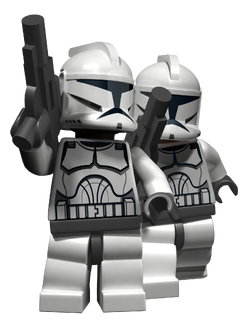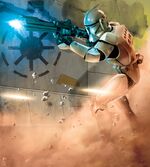| | |
- "A weapon they are. Obey orders without question for good or ill. For now they fight for us. Who is to say what the future holds?"
- ―Yoda
Clone troopers were highly trained soldiers in the Grand Army of the Republic. Representing the future of galactic warfare, clones were designed to be far superior to battle droids. During the last years of the Galactic Republic, clones formed the backbone of the Republic Military that waged war against the droid armies of the Confederacy of Independent Systems. The Clone Wars was named after the Republic's clone army, which became symbolic of the conflict that had spread throughout the galaxy after a millennium of peace.
Clone troopers were grown on the planet Kamino at the request of Jedi Master Sifo-Dyas, who commissioned the Kaminoans to build an army for the Republic, although some clones were secretly grown on Coruscant to supplement the army's numbers following heavy losses late in the war. After Sifo Dyas' death, the project was taken over by the Sith. Clones were modeled on a human template, the Mandalorian bounty hunter Jango Fett, although their genetic structure was modified to make them less independent and more docile than their progenitor. They were also designed to age at twice the rate of natural humans, accelerating their growth and making them ready for combat in a decade's time. As the Separatist Crisis gave way to open war, the Galactic Senate empowered Supreme Chancellor Palpatine to call the clone troopers into action, leading to their debut on the battlefield of Geonosis. For three years, clones fought the Separatist droids on all fronts across the galaxy. They were loyal to their Jedi Generals and the Supreme Chancellor; though some clones questioned their service, leading to isolated cases of desertion and treason, most were proud to serve the Republic as it was the only life they had ever known.
Galactic history was forever changed by a hidden behavioral modification biochip implanted in every clone, which was part of the Sith's plot to destroy the Jedi. Chancellor Palpatine, discovered by the Jedi to be the Sith Lord Darth Sidious, as well as the reason behind the Clone Wars, branded the Jedi as the enemies of the state and issued Order 66, with the latter being a calling for the annihilation of the Jedi Order. All across the galaxy, the clones turned against their generals, slaughtering them and storming the Jedi Temple on Coruscant under the stewardship of the Sith Lord Darth Vader. Sidious subsequently assumed absolute power as the self-proclaimed Emperor of the Galactic Empire. Clones initially served as Imperial stormtroopers in the New Order, but were soon replaced by human recruits and conscripts. Their armor, weapons, and training inspired generations of white-armored warriors.
History[]
Commissioning and the genetic template[]
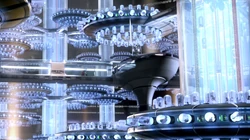
The cloning chambers in Tipoca City, primary cloning facility on Kamino
- "They grow up loyal to the Republic—or they don't grow up at all."
- ―Alpha, quoting Jango Fett
The origins of the clone troopers date back to the days[5] before the Invasion of Naboo in 32 BBY, when Jedi Master Sifo-Dyas, convinced that the Galactic Republic would soon face an existential threat, secretly commissioned Kaminoan scientists to create an army for the Republic. The project was discovered by Darth Tyranus, a former Jedi Master who turned to the dark side of the Force and became the Sith apprentice of Darth Sidious.[2] Tyranus betrayed and murdered Sifo-Dyas at Sidious' behest, and the two Sith Lords took over the project for their own ends.[1]
Before the cloners on Kamino were able to begin their task, they required an individual subject to serve as the army's genetic template. Tyranus, who had been ordered by Sidious to both search for an ideal candidate amongst the galaxy's deadliest mercenaries and eliminate a deranged former Jedi named Komari Vosa, devised a plan to accomplish the two objectives at the same time. Thus, he placed a five million credit reward on the capture of Vosa, who had become the leader of the Bando Gora. Whether she was dead or alive after her capture was irrelevant as the prize was the same either way. Among the mercenaries who received a special invitation from Tyranus was Jango Fett, a former Mandalorian who sought to make a living as a bounty hunter.[6]
When Fett successfully tracked and defeated Komari Vosa in combat, Tyranus personally congratulated the hunter and, in addition to the reward money, offered a substantial amount of more credits if Fett agreed to be cloned on Kamino. The purpose, as Tyranus revealed, was the creation of an army of clones, modified to grow at twice the rate of Human beings and programmed for absolute loyalty. Their training, supervised by Jango Fett, would turn them into perfect soldiers. After a moment of contemplation, Fett agreed to Tyranus' offer, but on the condition that the first clone would be given to him without any modifications.[6]
Before the gestation process began, the Kaminoans tampered with Fett's DNA to ensure that the clones were primarily dominated by behavioral genes that emphasized certain qualities such as loyalty, aggression, independence and discipline in order to guarantee that the army would be more docile and less independent than their template. Additionally, the Kaminoans increased their clones' lung capacity, decreased their reaction times and improved their stamina. Certain allergies and Fett's mild astigmatism were also removed from the genome.[7] Kal Skirata, a former Mandalorian warrior who had been brought to Kamino to assist in the training of a special unit, concurred with the Kaminoans' rationale behind "modified" troopers; an "unaltered" Jango Fett was not the ideal infantry soldier.[8]
Tyranus supplanted the Kaminoans with an inhibitor chip, which was to be instilled in the brain of each Clone. The chip was originally thought of by Sifo-Dyas, who intended for it to be a safeguard against rogue Jedi's, but following his death, Tyranus and Sidious retooled the chip. Tyranus, who posed as a Jedi, presented the retooled chip to the Kaminoans and deceived them into believing Sifo-Dyas's intention. The true purpose of the retooled chip was to brainwash the Clones into murdering their Jedi superiors for being perceived traitors to the Republic, in order for the Sith to reclaim control over the galaxy.
The Kaminoans also considered but rejected making the clone troopers sterile per their standard procedure for clone army projects. Senior research geneticist Hali Ke cited examples of sterile Human clones created for Tarshan Ring Excavations and infiltration squads created for the Lords of Purala IV, where clone prototypes displayed much higher rates of mental instability, poor unit cohesion, an inability to adapt and think creatively, and decreased aggressiveness in battlefield simulations. The Kaminoans found separating this from "Factor H"—the Human variable they deemed so essential to creating effective, aggressive soldiers—impossible, and so eschewed sterile clones in the name of military effectiveness.[7]
When the Kaminoans first began the cloning procedure, they had produced twelve prototypes, designated Null-class Advanced Recon Commandos. Due to the extreme modifications to their physiology, only half of the test subjects survived the gestation process. However, the "enhancements" that were made to the Fett genome left the survivors handicapped with erratic behavior and an inclination toward disobedience. Disappointed[8] with the unsatisfactory results[9] of their wayward creations, the Kaminoans deemed the six prototypes complete failures and intended to terminate them. Kal Skirata's intervention, along with Fett's support, prevented the clones from being liquidated. As a result, Skirata was charged with training the prototypes as intelligence units.[8]
Training[]
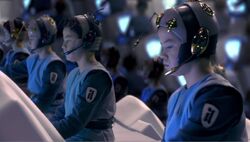
Created roughly five years before the Clone Wars, the younger clones physically resembled a ten year-old Jango Fett.
- "They're trained from day one to be more obedient than us."
- ―RC-3222
Due to the long-term commitment that was required in the creation of the clone army, Jango Fett took a hiatus from his bounty-hunting career to monitor the growth and training of his clones.[11] His influence over the clone army's development extended into several areas, such as the resemblance between his Mandalorian armor and the their Phase I armor and the training that molded the clones into elite soldiers.[2] One of his most significant contributions to the project, however, was his personal oversight of the Alpha-class Advanced Recon Commando, otherwise known as "ARC troopers."[4] The "second generation" ARC units were the Kaminoans' response to the failure of the Null-class. Unlike their precursors, the Alpha-class ARC troopers were more reliable for their loyalty to the Republic and willingness to serve under Jedi officers.[8] They were, however, superior and more creative in comparison to the rank-and-file clone troopers, due to their unaltered level of independence.[4]
Clones were decanted into birth cohorts of 32, and they trained, ate and slept alongside their batchers. These birth cohorts became the platoons clone troopers would fight in, having trained with their comrades literally from birth.[12] Through the technological capability to accelerate the speed of a clone's physical growth, the Kaminoans successfully engineered fully grown clones in half of the time that real Humans required to reach maturity. As a result of the genetic modification that enhanced their growth process, the clone troopers aged at twice the rate of Human beings. At the age of ten, a clone was resembling a young Jango Fett in his early twenties, and was thus fit and prepared for combat.[2]
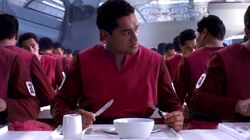
At the age of ten, adult clones physically resembled Jango Fett in his early twenties.
All clone troopers received basic training in core military skills, such as weapons handling, marksmanship, drill, and other essentials.[2][13] While Jango Fett personally handled the training of the Alpha-class ARC troopers,[8] a specialized unit of clone commandos was commissioned as a median between the independent-minded ARC troopers and the more docile rank-and-file clone troopers.[10] In order to ensure the overall success of the commandos project, Fett formed the Cuy'val Dar- a group composed of experienced Mandalorian mercenaries and even a few Journeyman Protectors. Though individual members of the group had their own unique training methods, as a whole, they separated the commandos into squads of four, which in turn created a strong sense of brotherhood amongst the commando squads.[8] Clones that were fit to serve in leadership capacity possessed notable traits, such as a greater degree of independence and creativity, as exhibited by commanders like Cody,[14] and Deviss.[15]
As part of their education and psychological training, the clone troopers were required to adhere to the Command Code, a set of guidelines that governed a clone's behavior and every action.[16] Hence, every clone was obliged to obey every aspect of the Code without question, doubt or hesitance.[17] Overall, the Kaminoans took a deeply vested interest in the training of the creations, especially the standard clone units[2] and even the clone commandos, as well.[18]
Mandalorian Heritage[]
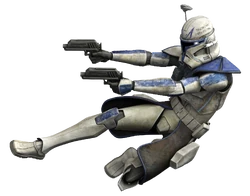
Clone Captain Rex was an independent thinker and skilled soldier, like his template, Jango Fett.
- "They'll do their job well. I'll guarantee that."
- ―Jango Fett
Through Jango Fett's connection to the clone troopers as a genetic template, as well as the presence of many Mandalorian trainers within the Cuy'val Dar, many societal aspects of Mandalorian culture were integrated into the mentality of many clones. The clone commandos were particularly susceptible to this outside influence since they experienced the most exposure to Mandalorians. Likewise, the Null-class ARC troopers were raised as Mandalorians by Kal Skirata. The use of Mando'a—the native language of the Mandalorians—began amongst the commandos and was gradually adopted by clone troopers of the rank-and-file stock.[8] One particular feature of the Mandalorian culture that the clone army assimilated was the "Jaig eyes," a mark of honor bestowed on soldiers for exceptional acts of bravery.[19] ARC Captain Fordo was commended with the Jaig eyes,[20] as was Clone Captain Rex[21]
Although Mandalorian influence was especially strong on the clone commandos,[8] the mainstream of the clone army held loyalty and obedience to the Galactic Republic as the overriding priority above all other concerns or interests.[2][22] The connection between the clone army and its Mandalorian heritage was greatly strained when Spar, a renegade Alpha-class ARC trooper, deserted the Republic and organized the Mandalorian Protectors on the side of the Confederacy of Independent Systems. The heavy casualties that the clone troopers endured due to the involvement of Spar and his Mandalorians at New Bornalex and Kamino[23] caused the clones to develop a strong sense of enmity toward the Mandalorians, whom they now regarded as enemies of the Republic. The troopers of the 2nd Airborne Company were openly hostile with Omega Squad because of the commandos' Mandalorian "upbringing."[22]
The end of the Mandalorian culture's influence over the clone army commenced with the production of new generations of clone troopers, grown and trained away from Kamino and under direct Republic supervision. The first wave of clones that eventually supplanted the original troopers were engineered through Spaarti technology, which was most notable for the fact that it developed fully matured clones in one year (as opposed to the longer Kaminoan method of ten years).[24] The decline of Mandalorian influence was further accelerated when the Galactic Empire's Stormtrooper Corps became dominated by enlisted troopers and clones based on different genomes, which thus reduced the remaining Fett clones to a minority status.[25][26]
Aberrations[]
Despite the Kaminoans' dedication to perfection when it came to their work, the cloning process produced a minority of clones with genetic abnormalities. Eye color proved particularly prone to variation, while many clones would have subtly different facial features to their fellow batchers. In some 3.5 percent of clones in each batch, however, genetic variations were so extreme that reconditioning was required, a euphemism that could include anything from genetic therapy to termination.[27] One instance included a company of clones that possessed less than 20/20 vision. They mysteriously disappeared in the late hours of the night and were never seen again.[8]
Terminations were largely halted after the Jedi took a more active role overseeing clone trooper training during the Clone Wars, with aberrant clones largely being shunted into support roles.[28] One genetically aberrant failure, 99, was relegated to janitorial responsibilities, since he was physically incapable of military service.[13] These procedures would still occasionally miss aberrants, such as the "Mad Clone of Kaikielius," who avoided being noticed during his growth and training only to go berserk during the Kaikielius campaign of the Clone Wars and murder his batchers in the belief that he was in a training simulation where his comrades had been replaced by disguised droids.[29]
The Clone Wars begin[]
- "An army of one man, but the right man for the job!"
- ―Clone trooper rallying call

Republic clone troopers were first deployed to Geonosis in 22 BBY.
In 22 BBY,[1] ten years after the start of the clone trooper program, the Jedi Knight Obi-Wan Kenobi tracked Jango Fett to the remote world of Kamino in the Outer Rim Territories. Much to his surprise, however, his arrival in Tipoca City was greeted with great anticipation from the Kaminoan cloners. Prime Minister Lama Su assumed that Kenobi had been sent by the Jedi Order to obtain a progress report on the Republic's clone army, and thus, he never realized that Kenobi was oblivious to the existence of the clones. Nevertheless, Kenobi inspected the clones for himself and learned from Lama Su that 200,000 units were prepared for deployment; another million were nearly combat-ready as well. When Kenobi attempted to apprehend Jango Fett, the bounty hunter escaped to the Separatist world of Geonosis. Kenobi pursued Fett, only to be captured and held hostage by Count Dooku, the former Jedi Master who secretly became the Sith Lord Darth Tyranus.[2]
While the Jedi Anakin Skywalker, and Senator Padmé Amidala of Naboo, conducted their own attempt to rescue Kenobi, the Galactic Republic fell into a crisis as the Separatist movement evolved into an armed rebellion. As a response to the revelation of the Separatists' intentions to secede through force, the Galactic Senate granted emergency powers to the executive branch of the government. With his new authority, Chancellor Palpatine accepted Kamino's clone army on behalf of the Senate, and thus, the Grand Army of the Republic was officially formed. Shortly afterward, Jedi Master Mace Windu assembled a Jedi task force to liberate Kenobi; Grand Master Yoda traveled to Kamino to inspect the clone army for himself.[2]
By the time Yoda and a force of 192,000[31] clone troopers arrived on Geonosis, the Jedi had been locked in a battle with the Separatist battle droids, but were ultimately overwhelmed, suffering heavy casualties. The clones successfully extracted the survivors, including Obi-Wan Kenobi, Anakin Skywalker and Padmé Amidala, as the first battle of the Clone Wars commenced. Under the leadership of the Jedi, the clone troopers quickly forced the droid army into full retreat. Although Count Dooku and the Separatist Council avoided capture, Geonosis ultimately fell to the Jedi and their clone forces; the Republic had secured the first victory of the war.[2]
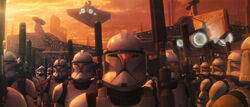
Clone troopers on Coruscant shortly after the First Battle of Geonosis
The victory on Geonosis was followed by the deployment of clone troopers throughout the known galaxy, where they served on various fronts against the growing Separatist Alliance. The members of the Jedi Order were commissioned as officers in the Grand Army of the Republic. Under the leadership of their Jedi commanders and generals, the clones engaged the Separatists on numerous battlefields; from Christophsis, Teth[21] and Ryloth,[32] to Hypori,[33] Jabiim,[34] and Kamino itself.[35] Despite the overall combat effectiveness of the clone troopers, their numbers steadily decreased throughout the war by attrition, an increasing rate of casualties, and their own accelerated aging process, Due to the clones maturation process, clone life expectancy was considerably short; many clones exhibited characteristics of far older men such as grey hair, receding hairlines, baldness and wrinkles. By 19 BBY, roughly three years after the first engagement at Geonosis, only two-thirds of the first generation clone troopers were still alive.[36]
A face and a name[]
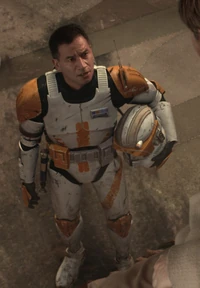
Clone Commander 2224, nicknamed "Cody"
- "There's not much to look at here, sir. We all share the same face."
"Deceive you, eyes can. In the Force, very different each one of you are." - ―Yoda and CC-4477 "Thire" on Rugosa
Though often viewed as the "flesh and blood" equivalent of battle droids, clone troopers possessed a capacity for individuality.[38] They were bred for no other purpose than combat, but nevertheless they developed as individuals under the guidance of their Jedi officers.[39] The Jedi's unique abilities and leadership prowess earned them the admiration and respect of the clones who served under them. Clone Commander CC-5052, nicknamed "Bly," felt that the Jedi were in command because they were the best in the Grand Army of the Republic.[40] Moreover most Jedi, such as Yoda,[41] Plo Koon[42], Aayla Secura[43], and Obi-Wan Kenobi considered the clones to as worthy of respect and life as any other beings, and went to great lengths to not waste the lives of their men.[21]
Clone troopers were officially identified by sets of letters and numbers. Every soldier's wrist was scannable and contained an identifying code, which displayed information such as designation, rank and battles fought.[44] Less than a year after the Clone Wars began, many clones adopted nicknames to complement their official designations with the approval of the Jedi.[21] Captain Rex speculated that efficiency was the reason clones had been permitted to have "names," due to the difficulty of distinguishing genetically identical soldiers at an individual level.[45] Another way that the Jedi fostered individuality in the clone troopers was through example; some clones respected their Jedi officers enough to emulate their leadership styles. Rex developed a sense of impulsiveness during his service under Anakin Skywalker. Cody had a strict adherence to procedure, a trait that was appreciated by Obi-Wan Kenobi.[14] The camaraderie that gradually developed between Jedi and clones was mirrored through others as well, including Aayla Secura and Bly,[40] or Plo Koon and the clones of Wolfpack.[46] Even though clones like CC-4477 ("Thire")[37] and "Sinker"[46] saw nothing unique about an army composed of clones from one genetic template, Grand Master Yoda sensed that each clone trooper felt different through the Force.[37]
Despite the great lengths that the Kaminoans took to ensure that all clone troopers were unconditionally loyal to the Galactic Republic, there was evidence of flaws within their work. Ordinary, standard-issue clone troopers were programmed to be absolutely subservient, but a few of them developed too much as individuals to the point where said loyalty was overridden. Examples included Clone Sergeant "Slick,"[47] "Ghost" and Cut Lawquane.[45] Tempted by thoughts of freedom and wealth, "Slick" became a spy for the Separatists while feigning loyalty to the Republic. He excused his treachery through his belief that the clones were enslaved, even though his actions caused the deaths of many of his "brothers" on Christophsis, much to the disgust of Cody and Rex.[47] Ghost, too, betrayed both the Republic and his fellow clones, selling his service to the Confederacy of Independent Systems in exchange for a way out of the war. Cut Lawquane began his life on Kamino like every other clone trooper, but later became a deserter after he abandoned his comrades during the First Battle of Geonosis.[45]
Smaller signs of individuality were seen in how some clone troopers broke away from the regulation haircut. Even before the mass production of Phase II armor, many clones had been allowed to customize their Phase I armor in various ways, either with color or additional equipment.[21] Aside from armor customization, another indication of individualism was the clone troopers' affinity for Kamino, which they regarded as their homeworld.[39] When Kamino was twice threatened by Separatist invasion, both Cody and Rex expressed concern for the safety of "their" planet.[48][35] In their second attempt, the Separatists reached Kamino and assaulted Tipoca City itself. Many clone troopers ultimately perished while defending the laboratories and military complexes that they viewed as "home."[35]
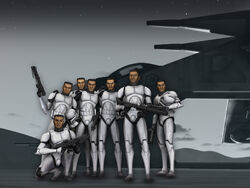
Clone troopers, comrades and soldiers of the Republic
In spite of the mutual respect between clones and Jedi, not everyone felt the same optimism about the clone troopers. Rahm Kota, a well-respected and highly skilled Jedi General, was not so easily fooled by the clones' seemingly innocent nature. Regarded as a military genius on the battlefield, Kota concluded that clone troopers made inadequate soldiers. "Real" Humans were unhindered by the modifications that Kota felt limited the clones, and thus he concluded they were ultimately more intelligent, intuitive and versatile than the clones. Hence, Kota formed his own militia and refused to have anything to do with clones.[49] Ironically, his distrust of clone troopers was vindicated when they betrayed and murdered their Jedi officers just before they went on to enslave the galaxy under the New Order.[50][25]
Aside from Kota, Jedi Master Quinlan Vos personally disliked the clone troopers, especially single-minded ones like Commander "Faie."[17] Some officers in the Republic Navy, especially those who joined the Commission for the Protection of the Republic, held clone troopers in a low regard as well.[24]
In addition, there were some alleged concerns within the legislature for the use of clones in war. This ultimately resulted in a law being passed via Senate decree late in the Clone Wars that confined military cloning to a few Republic facilities, as well as banning military-related cloning for all except closely regulated medical exemptions. The law also explicitly banned the purchase of sentient clones, sale of cloning equipment, or the employment of cloning specialists. However, the true purpose of these laws was to place a monopoly on the cloning enterprise.[7]
Palpatine's secret army[]
- "You worry too much, Clonemaster. I only require your clones to be fit for purpose, and that means they have no need to meet the exacting standards as the army bred on Kamino. The Grand Army has to be the very best in the galaxy for one single special operation ahead of them. This is the culmination of my strategy—two armies with two quite separate tasks."
- ―Chancellor Palpatine, to the Spaarti lead clonemaster supervising the production of a new clone army on Centax-2
After three years of constant warfare, the ranks of the Grand Army began to wear thin as the rate of battlefield attrition continued to increase and out-pace the ability of the Republic to breed and train replacement clones. Further, the remaining clone troopers were stretched thin throughout the galaxy during the Republic's Outer Rim Campaign. In response, Chancellor Palpatine who was secretly the Sith Lord Darth Sidious, secretly commissioned a new cloning operation, away from Kamino and under his direct supervision. Unknown to all except a select few, millions of clones were being engineered on Centax-2, one of Coruscant's moons.[24]
Developed in secret, the new clone army was distinguished from the original clone troopers by two main factors: the use of Spaarti technology by Arkanian Microtechnologies scientists. After relations soured between Chancellor Palpatine and Kamino Prime Minister Lama Su, Arkanian Clone Masters were contracted to develop additional clones in secret facilities on Centax-2. The use of Spaarti cloning cylinders enabled them to produce full-grown troopers in only one year, as opposed to the ten years needed for clones bred on Kamino.[24]
Given the short time required for the gestation process and the resulting accelerated growth to adulthood, the "Spaarti" clones required a rushed training regime. Through a flash-pumping program,[7] the clones were effectively "programmed" to be disciplined soldiers. However, the speed of their growth, compounded by their limited form of education, produced troopers with significantly decreased skills in key areas such as strategic thinking and marksmanship. Also, unlike the clone troopers from Kamino, the "Spaarti" clones showed very little individuality and were completely free of Mandalorian influence.[24]
The secret project ultimately produced millions of clone troopers, along with the necessary hardware of thousands of starships and weapons. This new army was scheduled for deployment in 19 BBY on a date roughly correlating with the third anniversary of the First Battle of Geonosis. However, before their scheduled debut, a limited number of "Spaarti" clones were field-tested through units such as the 14th Infantry Brigade, while others were assimilated into the 501st Legion and the Coruscant Guard's shock troopers.[24]
When Count Dooku and General Grievous led a Separatist surprise attack on Coruscant, which was orchestrated by Sidious, the Spaarti-bred clone army was unveiled for the first time. The introduction of several million new clones and thousands of new starships caught the Separatists by surprise, and proved essential to the Republic's eventual victory in the Battle of Coruscant. Another essential part of the battle was Sidious as Palpatine, betraying Dooku by having him killed by Anakin. In the immediate aftermath of the battle, the additional ships and men swelled the ranks of the depleted Grand Army as the Clone Wars quickly neared its end.[24]
Despite the obvious lower quality of the Spaarti clones in comparison to their Kaminoan-engineered brethren, to the extent that their Kaminoan counterparts described them as poor soldiers with only a rudimentary knowledge of battlefield tactics,[7] Chancellor Palpatine was not bothered in the least. During a conversation with a Clone Master from Arkanian Microtechnologies, Palpatine admitted that the new clones did not have to be of the same caliber as their precursors. He merely required the Spaarti clones to be the best soldiers for one specific operation- the true purpose behind their creation.[24]
Order 66[]
- "Execute Order 66."
"It will be done, my Lord." - ―Darth Sidious and Jaigalaar during the execution of Order 66
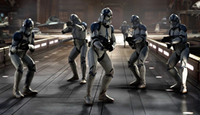
Sergeant Fox and the 501st Legion during Operation: Knightfall
On the eve of the end of the Clone Wars, the Jedi Council discovered the identity of Darth Sidious; the illusive Sith Lord responsible for the war was actually Supreme Chancellor Palpatine, leader of the Galactic Senate of the Republic. As a result, the Council chose to act swiftly in an attempt to neutralize Sidious as soon as possible. On behalf of the Senate, the Jedi Masters Mace Windu, Kit Fisto, Agen Kolar and Saesee Tiin marched into the Chancellor's Suite in the Republic Executive Building and, with lightsabers drawn, declared Chancellor Palpatine to be under arrest. Despite their efforts, however, the showdown between the Jedi and Sith ended with the deaths of all four Jedi Masters, as well as Anakin Skywalker's betrayal and fall to the dark side of the Force.[50]
Promoted to the position of apprentice to the Dark Lord of the Sith, the newly anointed Darth Vader marched into the Jedi Temple at the head of the 501st Legion; their mission was to kill every living being inside without exception. At the same time, Sidious issued Order 66 to the various clone commanders that were dispersed throughout the galaxy as deputies to Jedi generals and commanders. As one of 150 contingency orders for the Grand Army of the Republic, Order 66 labeled every Jedi as a traitor to the Republic. As a consequence, their clone soldiers were authorized to suppress the "Jedi insurrection" with deadly force.[50]
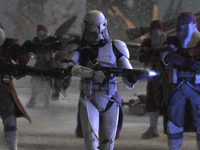
Commander Bacara and the Galactic Marines execute Order 66 without hesitation or remorse.
Upon Sidious issuing the order, the Clones inhibitor chips activated and brainwashed them viewing the Jedi as traitors to the Republic and subsequently eliminating them, without question. Though clones such as Cody[14] and Bly[40] came to respect their Jedi leaders after three years of warfare, their inhibitor chips forcibly eclipsed their loyalty to the Jedi.[50][14] For the most part, the Jedi failed to anticipate the betrayal of the clone troopers. Without a moment of hesitation, Cody ordered a nearby AT-TE to fire on Obi-Wan Kenobi, though the Jedi Master ultimately survived the clones' treachery. Other Jedi, however, were not as fortunate.[50]
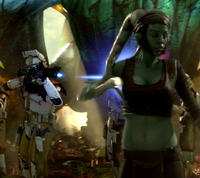
Aayla Secura is summarily executed by her clone troopers in accordance with Order 66.
The unsuspecting Ki-Adi-Mundi was ruthlessly gunned down by Commander Bacara and the Galactic Marines while in the midst of the Battle of Mygeeto; Aayla Secura was shot, repeatedly and fatally, on Felucia by several clone troopers, including Bly, the clone commander whom she enjoyed a close-working relationship with; Plo Koon, the Jedi Master who developed a deep affinity for the clone troopers, was murdered by Captain Jaigalaar on Cato Neimoidia; Stass Allie was betrayed and killed on Saleucami by Commander Neyo and CT-3423; Commander Gree tried to shoot Yoda in the back during the Battle of Kashyyyk, but was instantly beheaded with ease by the Grand Master. Despite this, all throughout the galaxy, the clone troopers complied with Order 66, and the Jedi that faithfully served the Republic in its time of need, at the risk of their own lives, were systematically slaughtered by the very soldiers they had come to trust and rely on.[50]
On Coruscant, no one inside the Jedi Temple was spared. Although a few survived the initial result of Order 66, such as Kazdan Paratus, Shaak Ti,[49] and Sha Koon,[51] nearly every Jedi that was caught in the Temple was killed by Vader and the clone troopers of the 501st. Masters, Knights, Padawans and even Younglings were murdered by their former comrade and the remorseless clones. When the sun rose on Galactic City, Operation: Knightfall was a success; the massacre of the Jedi Temple was complete.[50]
Dawn of the Galactic Empire[]
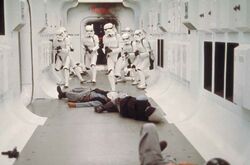
Imperial stormtroopers: the evolution of the Republic clone troopers
- "The clone troopers, now proudly wearing the name of Imperial stormtroopers, have tackled the dangerous work of fighting our enemies on the front lines. Many have died in their devotion to the Empire. Imperial citizens would do well to remember their example."
- ―Emperor Palpatine, during the Declaration of a New Order
Even as the clone troopers carried out Order 66, Darth Sidious called for an emergency session of the Senate, which he addressed in his public guise as Chancellor Palpatine. In what became known as the Declaration of a New Order, Palpatine gave his own account on the details of the event that preceded Order 66, naturally fictionalized in order to garner the overwhelming support of the Senate and the citizens of the Republic. In a prolonged speech regarding the downfall of the Jedi Order and the end of the Clone Wars, Palpatine announced that the Republic would be supplanted by a New Order; the first Galactic Empire, in which he would rule supreme as its first emperor.[50][53][54][55]
Just as the Republic was renamed and reorganized into the Empire, the clone troopers were also affected by Palpatine's reforms. No longer known as the clone troopers who defended the Galactic Republic under the leadership of the Jedi Order, the clones were anointed as Imperial stormtroopers. Without the guidance of their Jedi officers, the stormtroopers quickly became one of the most visible symbols of the new authoritarian regime, emphasized by the brutal manner in which they enforced the will of Emperor Palpatine.[50][39][56] In recognition of their loyalty and service to the Empire, the 501st Legion was placed under the direct command of Darth Vader. Under his direction, the 501st built a reputation of fear and brutality as "Vader's Fist."[25]
Despite the stormtroopers' betrayal of the Jedi Order and their new purpose as oppressors, the clones adjusted well to their Imperial duties;[57][25] CC-1119, nicknamed "Appo," was particularly pleased with the continued use of clones as military assets, especially due to his previous assumption that the clones would have been diminished as "glorified policemen" after the Clone Wars came to an end.[57] Over time as the Empire gradually asserted its dominance over the galaxy, Jango Fett's cloned progeny secretly enjoyed opportunities to destroy local insurrections, mainly because of their desire to maintain an efficient military while keeping the Empire feared by its own citizens.[25] The 1st Platoon, however, became a mercenary unit.[58]
End of the Fett cloning program[]
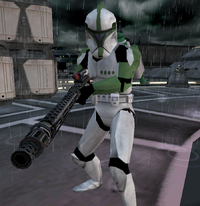
An Anti-Imperial clone trooper, created to liberate Kamino from the Galactic Empire
- "Since the Empire has redirected the clone trooper program to other pursuits and stepped up recruiting inferior humans from the Outer Rim, the operational effectiveness of this army has declined significantly."
- ―Commander Cody
When the Clone Wars came to an end, the Galactic Empire secured the vital cloning facilities of Kamino in order to ensure the continued production of cloned stormtroopers.[59] However, the Kaminoans resented the military occupation of their homeworld, which was ironically conducted by their own creations. As a result, a covert rebellion was formed as several clone masters plotted to liberate Kamino from Imperial control.[25] But even before the Republic's reorganization into the Empire, Prime Minister Lama Su reserved a portion of the clone troopers from the overall army that the Kaminoans engineered for the Republic. He later reflected on this decision near the end of the Clone Wars as relations between Coruscant and Kamino became strained.[24]
The preserved DNA samples of the Fett template provided the Kaminoan rebels with the means to forge a new army of clone troopers based on Jango Fett's genetic structure. Unlike their previous creations, however, the new generation of clones would be programmed with absolute loyalty to Kamino. After roughly a decade of operating in secret, the rebel clone army grew to full adulthood through the technology of accelerated growth. The majority was trained as anti-troopers; clone soldiers trained as jet troopers, armed with the DC-15A blaster rifle and the DC-15x sniper rifle, and equipped with Phase I armor. A new breed of Advanced Recon Commandos was created as a smaller, more elite force to complement the anti-troopers. These ARC troopers possessed the same armor as their predecessors and were armed with Z-6 rotary blaster cannons.[25]
At the same time, however, the Galactic Empire discovered the clandestine project and immediately reacted with force. The elite stormtroopers of the 501st Legion were dispatched to Kamino with orders to fully subjugate their own homeworld. Boba Fett, a bounty hunter and clone of Jango Fett, was hired by the Empire to serve as the 501st's mission commander, mainly because of his knowledge of Kamino's cloning facilities. In order to defeat the Kaminoan resistance with a decisive victory, however, the 501st Legion was commanded to annihilate their entire brethren of rebel clones.[25]
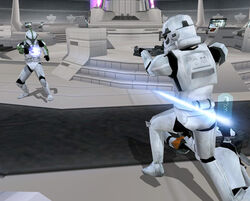
An anti-trooper and a stormtrooper fighting inside Tipoca City
Upon their arrival at Kamino, Boba Fett and the stormtroopers of the 501st Legion stormed Tipoca City in a direct assault on the planet's primary cloning facility. Despite the fierce resistance of the anti-troopers, the Imperials breached the facility's outer defenses and retrieved a sample of Jango Fett's DNA. Meanwhile, the fighting intensified on Tipoca City's platforms as Fett clones from both sides killed each other. As the Imperials steadily took more ground on the platforms, a new objective directed their efforts toward the destruction of the incomplete rebel clones. Though initially deterred by a force of ARC troopers, the Imperials infiltrated the cloning labs, destroyed the clone tanks' life support systems and killed their "brothers" who were still in the process of development. Without reserve stocks to provide additional troopers to the rebel army, the clones attempted to evacuate their Kaminoan masters on two LAAT/i gunships. Both vessels were ultimately destroyed, and with the deaths of the last remaining rebel clone troopers, the Kaminoan resistance collapsed as the Empire claimed victory over Kamino.[25]
The incident of the Clone Rebellion on Kamino was regarded by the Galactic Empire as highly confidential; the information was classified and kept out of the public's knowledge. Though the 501st Legion proved its unwavering loyalty once again, even to the extent of killing their fellow Fett clones, Emperor Palpatine decided to reconsider his reliance on an entire army cloned from just one source. The creation of the anti-troopers had demonstrated the inherent danger in over-dependence on a single template of clone soldiers; the corruption that they were easily susceptible to was too great of a risk to the Empire's security. Hence, new stormtroopers were cloned from a variety of additional genetic templates. The 501st Legion was allowed to maintain "Fett purity" within its own ranks, but the rest of the Imperial Army became increasingly diverse through different clones and enlisted troopers. None of the Fett clones, especially the ones who served in the 501st, were able to reconcile themselves to the fact that they had been marginalized into a minority within the army that they once filled as a whole.[25]

The fall of Kamino's cloning facilities ended the Clone Rebellion.
The diversity continued to spread throughout the ranks over the next decade as more male Humans were recruited from the Outer Rim Territories and trained as stormtroopers. By this time, the few remaining Fett clones that survived the Clone Wars still carried a strong sense of hatred for all troopers who did not originate from Jango Fett's template. Their animosity extended particularly toward enlisted troopers. Commander Cody, the clone who originally served under Jedi General Obi-Wan Kenobi, became bitter and nostalgic due to the significant decline in the military's operational effectiveness ever since the Empire increased the rate of recruitment for the stormtrooper ranks. Cody had an extremely low opinion of enlisted troopers and regarded them as "idiots" that lacked any sense of themselves or their surroundings. As a veteran of the Clone Wars who once hailed from the Grand Army of the Republic, Cody despaired over the quality of the Stormtrooper Corps, which he saw as an embarrassment to the legacy of a once truly remarkable military force.[26]
As the clones serving under the Empire grew older, their bodies began to degenerate at an increased rate. Imperial researchers discovered that years of exposure to battlefield contaminants and sustained stress had created mutations that accelerated their aging by more than twice the normal rate.[22] By the time the clones reached the equivalent of their forties, many presented biomarkers that displayed they were in their fifties and sixties. This rapid degradation of the clone's tissue forced the Empire to retire most of their oldest remaining clones to the VetCenter on Coruscant.[18][10] The Empire attempted to curb the loss of their most experienced soldiers by transforming aging clones into cyborgs under the Phase Zero Dark Trooper program, but this endeavor was ultimately deemed a failure after the clone subjects proved too mentally unstable after their transformations to continue living.[60]
Legacy[]
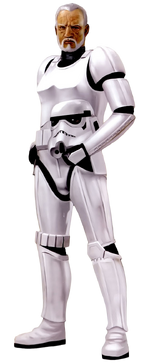
TH-313, a Captain within the Stormtrooper Corps
Even though Fett-based clones had largely been shelved, with cloning even being considered a clandestine science after the rise of the Empire, military-related cloning and research had not ceased. Various top-secret facilities conducted research on creating Force-sensitive prime clones,[7] similar to the clones X1 and X2 from the Clone Wars.[61] In addition, Grand Admiral Thrawn ended up making the discovery that using ysalamiri to sever a developing clone's connection to the Force resulted in the creation of mentally stable clones to be created in mere weeks, a discovery he later intended to use to his advantage during his actions against the New Republic.[7]
Equipment[]
- "Take care of the equipment, Eight-Three."
"And the equipment will take care of us, Seven-Four." - ―Seven-Four and Eight-Three
Armor[]
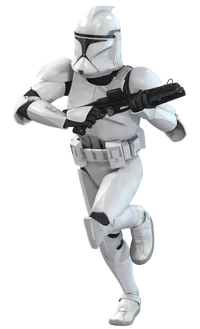
The first clone troopers were equipped with Phase I armor.
During the development of the first generation of clones, Kaminoan armorsmiths[63] forged Phase I battle armor; the military combat uniform of the clone troopers. The armor was loosely based on the design of Jango Fett's Mandalorian shock trooper armor. The most notable feature of Mandalorian influence in the armor's design was the helmet's distinctive T-shaped visor. The full uniform consisted of twenty[36] plastoid[9] armor plates, attached to a black body glove. Other aspects of the armor included the helmet's breath filter, a utility belt and the boots' high-traction soles.[36]
At the beginning of the Clone Wars,[2] Phase I battle armor used color to distinguish clone officers from each other and the rest of the rank-and-file stock. For instance, commanders were marked by yellow stripes; captains, lieutenants and sergeants were identified by red, blue and olive green respectively.[63] However, this system of military uniformity was relaxed early in the war, and color was used in some cases to indicate unit affiliation instead of rank. Though many clone troopers maintained their armor in traditional white] other clones—particularly officers—customized their uniforms through color and design.[21] In recognition of their achievements, some clones were allowed to add specific designs to their armor, such as a Mandalorian award known as "Jaig eyes."[19][20][21]
The clone troopers who received specified training for various roles other than infantry were equipped with variant forms of Phase I battle armor. Clone pilots wore the same armor as regular troopers, but were distinguished by yellow markings and specialized full-face helmets.[36] Clone flame troopers were protected from the potential dangers and setbacks of their own role by insulated body gloves and suits chilled by coolant reservoirs.[38] Clones assigned to noncombative assignments, such as medical officers[64] and naval officers, wore military dress uniforms, similar to the design of attire of Human officers in the Republic Navy.[21]

Clone troopers in various forms of Phase II battle armor
The principal drawback of the Phase I battle armor, however, was its heavy and uncomfortable design. Hence, it was disparagingly referred to as the "body bucket." As a result of such imperfections, the flaws of Phase I were eliminated through the conception of Phase II battle armor.[36]
As the Clone Wars, progressed, Phase I was ultimately rendered obsolete when the clone troopers switched to its Phase II successor. The new armor was designed to be superior to its predecessor in every aspect; stronger, lighter and more adaptable. This advanced armor also possessed many specialist variations,[36] suited to clones such as scout troopers, paratroopers and AT-RT drivers.[50] But due to the rigors of war, Phase II battle armor was more battle-dented and mud-smeared than the Phase I precursor.[36] The practice of color design and armor customization was carried over to the new armor as well. By the time of the Battle of Coruscant in 19 BBY, various clone divisions were visually distinguished from each other primarily through different color designs.[50]
Weapons and kit[]

Clone troopers in specialized armors
The nonspecialized clone trooper's primary weapons for ranged combat were the DC-15A blaster rifle and its more compact counterpart, the DC-15S blaster carbine.[2] In addition, clone troopers often carried one or more grenades of varying types, such as the Merr-Sonn V-1 thermal detonator, LXR-6 concussion grenades, V-6 haywire grenades,[65] and "droid popper" electromagnetic pulse grenades.[18]
The pouches and compartments of a trooper's highly functional utility belt contained a multitude of equipment, including a grappling hook, spare ammunition, ration supplies and a rudimentary medical kit containing enough synthflesh and bacta to keep a wounded soldier alive until a medic could arrive. While neither was part of their official-issue kit, most clone troopers also carried multitools and a pack of sanitary wipes.[66] Clone troopers were outfitted at Grand Army troop centers.[67]
Specialized clone troopers[]
In addition to the standard infantry troopers that composed the bulk of the clone army, a select number of clones were trained for specialized roles, such as piloting[36] and command.[38] As the Clone Wars progressed, more clone trooper variants were deployed, from jet troopers[65] and flame troopers[38] to Advanced Recon Commandos[35] and Covert Ops clone troopers.[22] In addition, regular clone troopers could carry heavier weaponry and armor and carry the designation of Heavy clone trooper and Repeater clone troopers.[67]
Combat role-specialized variants[]
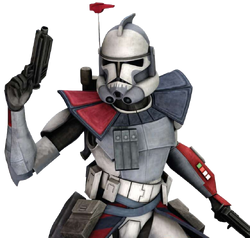
ARC Commander Colt in Phase II armor
- Advanced Recon Force troopers carried out reconnaissance and surveillance for Jedi Generals.[21]
- Advanced Recon Commandos performed special reconnaissance missions. Regular clone troopers could be promoted to the rank of ARC trooper.[35]
- Alpha-class Advanced Recon Commandos represented the GAR's most elite and deadly soldiers.[4]
- Null-class Advanced Recon Commandos, though deemed failed experiments, were activated as the GAR's lead clone Intelligence units.[8]
- Blurrg troopers were troopers who rode blurrgs and carried flamethrowers for anti-armor roles.[67]
- Clone assassins were engineered with fast reflexes, trained in stealth, and armed with vibroblades.[68]
- Clone commandos trained, lived, and worked together in four-unit squads to perform covert operations that were too complex for ordinary troopers. They were regarded as superior to standard clone troopers, though not quite the equals of ARC troopers. They were trained by mandalorian sergeants, hand picked by Jango Fett, called Cuy'Val Dar.[18][10]
- Clone blaze troopers were equipped with heavily armed and armored battle suits, designed for heavy engagements.[68]
- Clone marines were specifically trained to repel Separatist boarding parties, as well as to board and sabotage enemy capital ships.[25]
- Covert Ops clone troopers were trained for stealth missions, including assignments that marked clone deserters for summary execution.[22]
- Clone ordnance specialists were troopers trained for the disarmament and disposal of explosive weapons.[69]
- Clone scout troopers performed reconnaissance and scout missions.[50]
- Clone trooper commanders combined enhanced tactical knowledge with advanced combat skills.[2]
- MEC trooper, a heavily armed class of clone trooper variants.[70]
- Clone shadow troopers were an elite group of stealth units trained for covert operations that pertained to Republic Intelligence jurisdiction.[71]
- Clone shock troopers of the elite Coruscant Guard under Homeworld Security Command were tasked with enforcing law and order on Coruscant.[21][50]
- Included riot clone troopers, who received additional training in riot control.[64]
- Clone trooper medics were trained to diagnose and treat wounded soldiers in the field.[45]
Environment-specialized variants[]
- Clone cold assault troopers were trained specifically for battle and survival in extremely cold regions.[72]
- Clone SCUBA troopers were adapted for aquatic warfare.[73][74]
Equipment-specialized variants[]
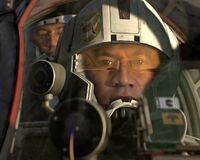
A clone pilot
- Anti-air clone trooper carried missile launchers for use against aerial targets.[67]
- AT-RT drivers piloted All Terrain Recon Transport walkers.[50]
- AT-TE commanders led the massive All Terrain Tactical Enforcer walkers.[32]
- BARC troopers were expert BARC speeder riders.[50]
- Clone blaze troopers and clone trooper grenadier provided heavy, close range anti-troop firepower.[68]
- Clone engineers were a special group of troopers trained in vehicle maintenance and demolition work.[25]
- Clone heavy troopers were heavy weapons specialists, equipped with specialized armor, and armed with missile and rocket launchers.[25]
- Clone jet trooper were equipped with jetpacks and trained for aerial combat.[25]
- Clone lancer troopers operated speeder bikes and jousted with power lances.[75]
- Clone paratroopers were an elite group of clones specially made for high-altitude combat jumps, and thus they were equipped with specialized helmets and armor.[50]
- Clone snipers were specialized troopers whose primary objective was to kill enemies from a distance.[25]
- Clone heavy gunners were troopers that specialized in heavier anti-troop weapons.[68]
- Clone trooper pilots were trained to fly a wide range of vehicles, from the LAAT gunships to the ARC-170 starfighters.[50] They also served as field technicians.[65]
- Clone flame troopers were specialized in using flamethrowers and other incendiary weapons.[38]
- Clone trooper grenadiers carried mortars.[67]
- Clone trooper medics carried equipment to diagnose and treat fellow clones in the field.[45]
- Special ops clone troopers were called in for dangerous and difficult missions.
Other variants[]
Rebel Clones[]
- Anti-troopers were designed specifically for the rebellion on Kamino. They were programmed with absolute loyalty to their Kaminoan Clone Masters and trained as jet troopers.[25]
- Rail-class Advanced Recon Commandos were the latest known generation of ARC troopers, equipped with Phase I ARC armor and armed with chainguns. They were created to complement the anti-troopers of the Kaminoan resistance movement.[25]
Rank notation[]
At the start of the Clone Wars, rank of the troopers was determined by color worn on their helmet, arm and shoulder armor.[2] In time, however, some clone officers were allowed to design and customize their armor. Notable examples included Commander Fox and Captain Rex.[21]
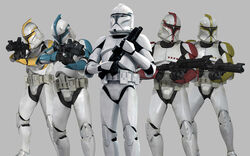
Early in the war, specific color denoted rank.
- White—Private (standard trooper).[15][2]
- Olive green—Sergeant; commanded squads made up of nine troops.[15][2]
- Blue—Lieutenant; commanded platoons composed of four squads (36 troops).[15][2]
- Red—Captain; commanded companies made up of four platoons (144 troops).[15][2]
- Yellow—Commander; commanded regiments made up of four battalions (2,304 troops).[15][2] Many of these commanders were grown with more capacity for independent thought than the rank-and-file clones,[25] and were sometimes known by nicknames rather than numbers.[50] They also received training from the ARC trooper Alpha-17.[15] Notable clone commanders included Cody, Bly, Gree, Bacara, Appo, Neyo, and Thire.[50]
With the development and distribution of Phase II battle armor, clone troopers ceased using color markings to denote rank. Instead, color patterns on troop armor signified legion designation and position.[50] Troopers with Phase II armor, such as Commander Cody, also wore colored stripes along their arms indicating the campaigns they served in.[76]
Designations[]
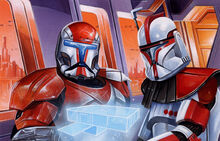
A Republic Commando (left) and ARC trooper Null-11 (right)
Clone trooper commanders received the designation CC-(number)[15] or CRC (for clone regimental commander).[77] Null-class Advanced Recon Commando were designated N- or Null-.[8] Alpha-class Advanced Recon Commando were identified with an A- or Alpha- designation,[4] and clone commandos the RC- (for Republic Commando) designation.[18] Clone trooper captains and Clone trooper lieutenants were designated CC- or CL-, respectively.[21][2] The CT- designation was for Clone trooper sergeants and rank-and-file clone troopers.[15]
Clone trooper units[]
- 05 Commando battalion
- 2nd Airborne Company[50]
- 5th Fleet Security[78]
- 7th Legion
- 7th Sky Corps[50]
- 9th Assault Corps[50]
- 14th Infantry Brigade[24]
- 38th Armored Division[79]
- 41st Elite Corps[80][81][82]
- 44th Special Operations Division
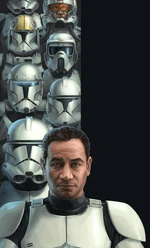
Various types of clone troopers
- 55th Mechanized Brigade[24]
- 85th Infantry Brigade[24]
- 91st Reconnaissance Corps[50]
- 104th Battalion
- 182nd Legion[25]
- 187th Legion[83]
- 203rd Division
- 212th Attack Battalion[50]
- 327th Star Corps[50]
- 416th Star Corps
- 442nd Siege Battalion[9]
- 501st Legion[50]
- Breakout Squad
- Combat Engineer Battalion[79]
- Coruscant Guard[50]
- Domino Squad
- Galactic Marines[50]
- Lancer Battalion[75]
- Rancor Battalion
- The Muunilinst 10[84]
- Sky Corps[15]
- Special Operations Brigade
- Squad Seven[76]
- Wolfpack
Behind the scenes[]
All of the clone troopers were digitally created in both Attack of the Clones and Revenge of the Sith. Their voices were provided by Temuera Morrison, who also provided the faces for Commander Cody, Odd Ball, and Captain Jai'galaar, wearing a blue bodysuit that would be replaced in post production by the character's clone trooper armor. Morrison also provided the voice of clones in many games, principally Star Wars: Republic Commando (while the regular clones were voiced by Roger Jackson) and the Battlefront series. Younger clones were portrayed by Daniel Logan (in Attack of the Clones) and Bodie Taylor (in both Clones and Sith). In the Clone Wars cartoon, the voice of the clone troopers was provided by André Sogliuzzo. In the Revenge of the Sith game, Andrew Chaikin voiced the clone troopers, and Dee Bradley Baker voiced the clone troopers in Star Wars: The Clone Wars.
Before the release of Attack of the Clones, Expanded Universe authors and fans often assumed that the clones of the Clone Wars would be on the side against the Republic. This misconception was caused by promotional material portraying the clones as the background for Dooku, Jango Fett, et al. This is half true as the army was really created as part of Palpatine's plot to destroy the Jedi.
In Star Wars: The Force Unleashed, the player may enter LEGION as a cheat code to unlock the playable clone trooper skin.
The design of the clone trooper armor is similar to the armor used by the Republic troopers, the predecessors of the clone troopers in the pre-Clone Wars era. This implies that some of the clone trooper's armor could have been based on that design, once the Galactic Republic became affiliated with Kamino.
Appearances[]
Non-canon appearances[]
Sources[]
Non-canon sources[]
Notes and references[]
External links[]
 Clone trooper on Wikipedia
Clone trooper on Wikipedia- What Happened To Han And Leia? How About Jar Jar? 'Star Wars' Emperor Lucas Speaks - MTV.com article where George Lucas discusses the transition from clone troopers to stormtroopers



